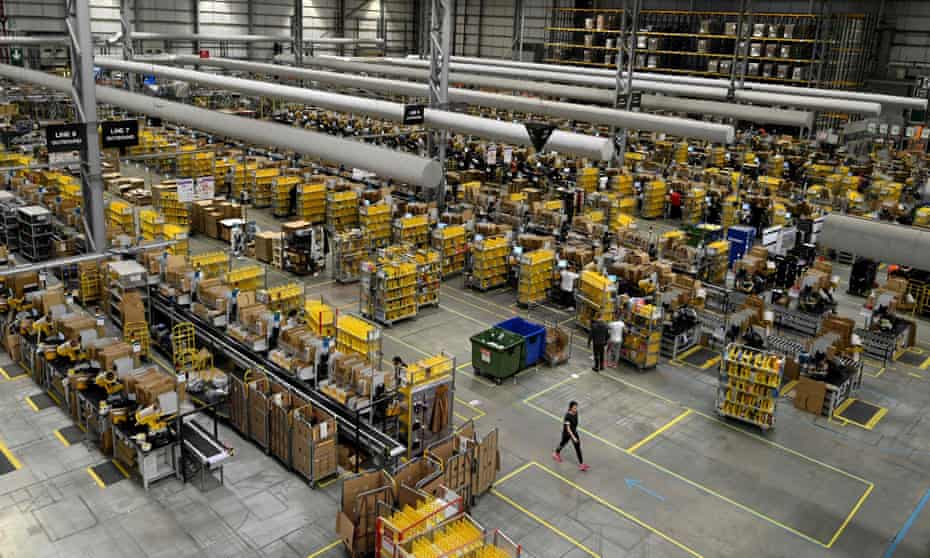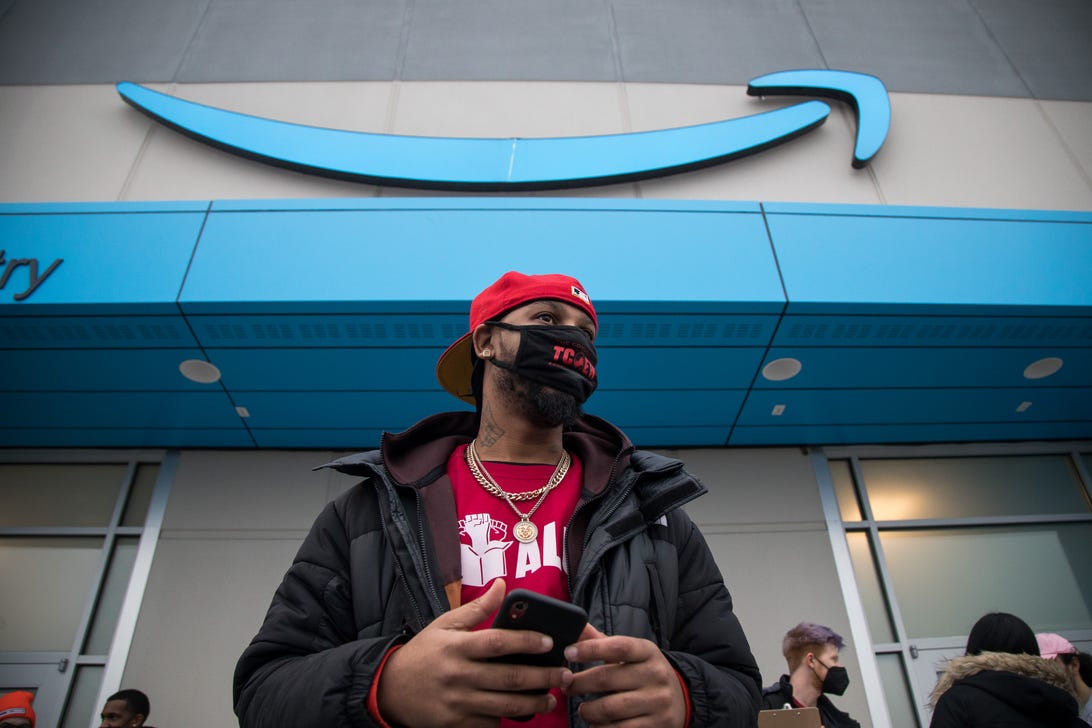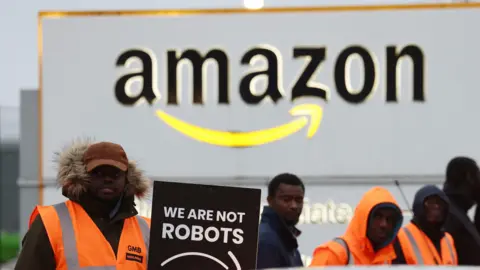Amazon has earned the dubious distinction of replacing Walmart as the nation’s fiercest anti-union employer

‘Amazon seems averse to letting its employees utter a pro-union peep.’
Photograph: Daniel Leal/AFP/Getty Images
Fri 4 Feb 2022 11.28 GMT
It doesn’t take much imagination to realize that Amazon warehouse workers would benefit from having a union. The average Amazon warehouse worker leaves within just eight months – that’s an unmistakable sign that Amazon’s jobs are unpleasant, to put it kindly, and that many Amazon workers quickly realize they hate working there because of the stress, breakneck pace, constant monitoring and minimal rest breaks. Indeed, experts on the future of work often voice concern that Amazon’s vaunted algorithms and technologies treat Amazon’s warehouse workers like mindless, unfeeling robots – having them do the same thing hour after hour after hour.
And then there are the endless tales from Amazon warehouse workers that the company is so stingy about break time that they often don’t have enough time to go back and forth to the bathroom without getting demerits for exceeding their allotted daily break time. It’s hard to believe that here in the 21st century, one of the nation’s biggest, most respected companies makes it so hard for many of its workers to pee.
Fri 4 Feb 2022 11.28 GMT
It doesn’t take much imagination to realize that Amazon warehouse workers would benefit from having a union. The average Amazon warehouse worker leaves within just eight months – that’s an unmistakable sign that Amazon’s jobs are unpleasant, to put it kindly, and that many Amazon workers quickly realize they hate working there because of the stress, breakneck pace, constant monitoring and minimal rest breaks. Indeed, experts on the future of work often voice concern that Amazon’s vaunted algorithms and technologies treat Amazon’s warehouse workers like mindless, unfeeling robots – having them do the same thing hour after hour after hour.
And then there are the endless tales from Amazon warehouse workers that the company is so stingy about break time that they often don’t have enough time to go back and forth to the bathroom without getting demerits for exceeding their allotted daily break time. It’s hard to believe that here in the 21st century, one of the nation’s biggest, most respected companies makes it so hard for many of its workers to pee.
In this way, working at Amazon resembles working at a poultry processing plant, where workers often wear adult diapers to work because their bosses frequently tell them they can’t take a break right now from cutting all those drumsticks and wings to go to the bathroom.
Amazon workers continue to endure all this pain and strain even though Jeff Bezos, Amazon’s founder and the world’s richest human being, has said he is committed to making Amazon “Earth’s Best Employer and Earth’s Safest Place to Work”. Evidently Bezos fails to realize that any company whose workers leave after eight months on average is light years from being Earth’s Best Employer. As for being Earth’s Safest Place to Work, Bezos shouldn’t insult workers’ or the public’s intelligence by making such a claim, considering the rate of serious injuries at Amazon’s warehouses in 2020 was nearly twice that at other warehouses across the US.
If Amazon were to be the Earth’s Best Employer, then its employees would probably be eager to work there until age 65 or 70, rather than say good riddance after a few months. By the way, the eight-month average that Amazon workers stay is a piddling one-sixth the average job tenure for America’s 155 million workers.
However much Bezos detests unions, there’s one thing Bezos can’t honestly deny –unions would be a surefire way for Amazon to become a better employer. Indeed, if Bezos is serious about making Amazon Earth’s Best and Safest Employer, not only should Amazon stop fighting so hard to block unionization, as it has in Alabama, Staten Island and elsewhere, but it should roll out the red carpet for union organizers. If Amazon workers had a real voice at work, a real voice in shaping and improving Amazon’s working conditions – perhaps in de-stressing and slowing down Amazon’s the-algorithm-uber-alles work routines – Amazon might become a far better place to work, and perhaps take a few steps closer to Bezos’s much-ballyhooed goal of becoming Earth’s Best Employer. (I would settle for Amazon becoming Earth’s Best Warehouse Employer – Best Employer is a laudable goal, but a bridge way too far for Amazon.)
If Amazon workers had an effective union that improves pay and conditions, they might stay for eight years on average instead of eight months. In that way, a union might go far to cure Amazon’s biggest headache: it chews through so many employees so fast that it is always desperate to hire new workers – more than 500,000 new hires some years (before quickly chewing through those new ones and spitting them out). Deep down, Amazon executives must be terrified that at some point, so many millions of Americans will have gone through and been chewed up by the Amazon push-it-to-the-max, stress machine, that Amazon simply won’t be able to find enough workers to keep all its warehouses operating – unless, perhaps, it raises its starting pay to $25 or $30 an hour.
Some labor experts see an anti-union method to Amazon’s stress-o-matic madness: that it intentionally wants its workers to stay only a short time because its workers will then conclude that they won’t be there long enough to make it worthwhile to fight for a union. Besides, with such enormous employee turnover and with so many workers staying for such a short time, that makes it immensely hard for union organizers and union-supporting workers to explain to all of a warehouse’s workers how they would benefit from having a union.
Making it even harder to unionize Amazon is the company’s apparent willingness to violate labor laws
To say that unionizing Amazon is an uphill battle is an understatement. It’s one thing to unionize a Starbucks cafe with 30 baristas – and that’s quite hard, considering how aggressively anti-union Starbucks is. But it’s a whole different level of difficulty to unionize a warehouse with 5,000, especially when Amazon pumps out anti-union propaganda to its workers 24/7, while it prohibits union organizers from setting foot on company property.
Making it even harder to unionize Amazon is the company’s apparent willingness to violate labor laws. Fed up with Amazon’s numerous alleged labor law violations at its warehouse in Bessemer, Alabama, the National Labor Relations Board pressured Amazon into reaching a settlement in December in which the company promised to comply with federal laws that protect workers’ right to unionize.
But just a month after that settlement, the NLRB again accused Amazon of serious labor law violations, this time at its Staten Island warehouse. In a complaint issued on 27 January, the NLRB said that one of Amazon top anti-union consultants, Bradley Moss, had called union organizers “thugs”, a word that some see as racially insensitive considering that most of the organizers in Staten Island are Black. The NLRB also said Moss had told workers it would be “futile” to vote for a union because a union would “never happen here”. The NLRB said Amazon committed other illegalities; confiscating pro-union literature, preventing workers from distributing flyers in break rooms and telling workers they couldn’t distribute union literature without Amazon’s permission. Amazon denies the NLRB’s allegations. While Amazon pushes its anti-union message to the max – remember the anti-union posters it put in its toilet stalls – Amazon seems averse to letting its employees utter a pro-union peep.
Amazon has earned the dubious distinction of replacing Walmart as the nation’s fiercest anti-union employer. This week, more than 6,000 workers at Amazon’s warehouse in Bessemer are getting a second chance to vote on whether to have a union; the NLRB ordered a new election after asserting that Amazon’s illegalities prevented a fair, first union vote there.
The bottom line here: not only would unionizing Amazon make it a better place to work – something Bezos says he badly wants – but a successful unionization vote at Amazon would be a huge, hopeful signal to embattled workers across the US that even at a fiercely anti-union corporation like Amazon, workers can indeed choose to have a union as a surefire way to improve their jobs and their lives.
Steven Greenhouse is a journalist and author, focusing on labor and the workplace. He is a senior fellow at the Century Foundation and the author of Beaten Down, Worked Up: The Past, Present, and Future of American Labor











 Members of the Retail, Wholesale and Department Store Union distributed literature outside the Alabama warehouse where Amazon workers are voting on whether to join the union.Credit...Bob Miller for The New York Times
Members of the Retail, Wholesale and Department Store Union distributed literature outside the Alabama warehouse where Amazon workers are voting on whether to join the union.Credit...Bob Miller for The New York Times
 Amazon’s “inSTALLments” program used postings in warehouse bathrooms to communicate with workers.Credit...The New York Times
Amazon’s “inSTALLments” program used postings in warehouse bathrooms to communicate with workers.Credit...The New York Times





